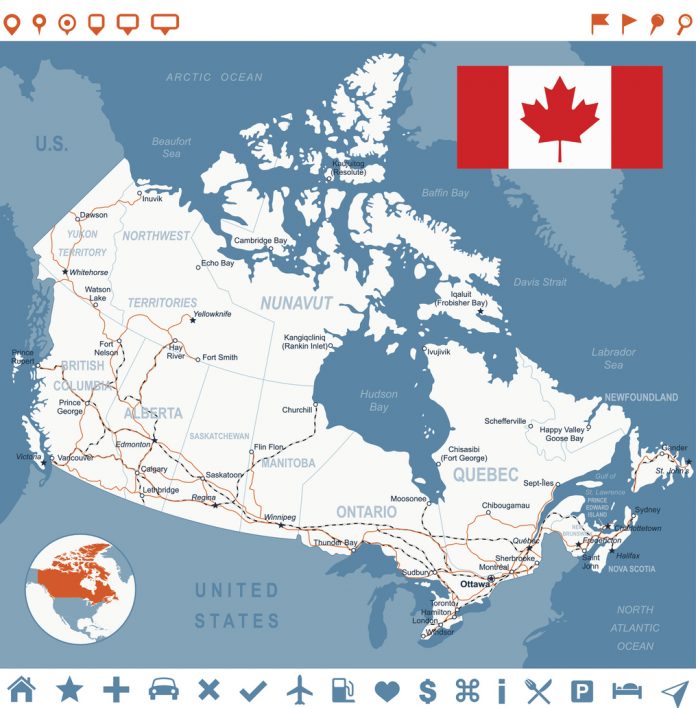Trucking is one of the most important pillars of transportation in the Canadian supply chain. Canada’s extensive road network prove the primary mode of transport used to ship goods across the country. The trucking sector is also the key mechanism for trade with the United States – Canada’s number one trading partner. However, the lack of harmonized regulations, both among the provinces and various countries, hinders the flow of trade. In addition, the trucking sector faces many challenges in responding to the growing demand and the driver shortage is currently a major cause for concern. (Expected 2023 driver shortage 25,000) Without counting the effects of the COVID‑19 pandemic, at a time where climate change has generated global concerns, the trucking sector is also being asked to reduce its environmental footprint, which presumably will require shifting to more environmentally friendly heavy vehicles.
How is the Canadian west being won?
From east to west Canada flexes its roadway muscles for 5,514 KM’s and 4,634 KM from north to south. With such vastness comes huge challenges for the timely transportation of goods coast to coast to coast. Western Canada transport truck drivers face adversity from Weather and very long hauls to name the top two. While covering such a huge non-populated area driving can become a very lonely and dangerous occupation. However, many tech advancements are being made today to make it possible to safely navigate these western roads with such features as…Satellite GPS, on board driver laptop, automated driver assist features, stability control, comfort features and automated braking and lane change sensors.
The lack of Western commercial truck drivers has hindered the efficiency of the total Canadian supply chain, creating a vicious cycle. However, this shortage occurs all over Canada. In some cases, the shortage of trucks and trailers adds to the lack of fulfillment of additional drivers. Truck and trailer manufacturers are falling short in meeting market demands in Canada. Primarily because they still do not have the supply of necessary components and microchips that are needed to build the trucks. Even the big players of the industry are handling long backlogs to meet the orders, limiting the supply of operational trucks on road.
In Western Canada, the Port of Vancouver, Canada’s busiest port, handled 0.9% more tonnes of freight in 2020 (145.5 million tonnes). In the first quarter of 2020, container and bulk volumes handled saw a large drop due to the railway blockades, the economic slowdown in Asian countries as measures were implemented to control the spread of COVID-19 as well as the decline in North American demand for consumer goods. Following the initial decline, higher volumes than usual in the fall and winter allowed for a complete recovery led by large rises in grain products, potash and fertilizers as well as petroleum products.
Focus: Hauling by Western Canada provinces
British Columbia
The trucking industry in British Columbia is a significant contributor to the economy of the province. According to Statistics Canada, truck transportation is a $2.7 billion industry in BC. (for-hire trucking, not private trucks carrying goods for their own companies). Between 2007 and 2016, trucking grew by 30%, at an average rate of about 3.0% per year. The British Columbia Trucking Association (BCTA) is committed to safety and is recognized as the voice of the provincial motor carrier industry. It supports the trucking industry in British Columbia which plays a big role in transportation and delivery of highly specialized loads.
B.C. could very well fill a list of most dangerous highways in Canada, given the number of mountain passes, steep grades, and sheer sense of peril. The Trans-Canada highway through the province poses its challenges because of geography, including steep grades and sharp turns. There are more kilometers of two-lane highway between Kamloops and Alberta than there are between the B.C.-Alberta border and Ontario. Winter highway maintenance standards with more stringent conditions are now in place. Service Area 11 (East Kootenay) is the first to be subject to these new standards, and two areas on Vancouver Island followed.
Alberta
Alberta’s economy has momentum and economic corridors play a critical role in moving goods efficiently and keeping Alberta markets connected. The Ministry of Transportation and Economic Corridors provides a safe and efficient transportation system to support Alberta’s economic, social and environmental vitality. The Economic Development in Rural Alberta Plan sets out a 5-year commitment that guides rural economic growth, reflecting on innovation, diversification, and sustainable, long-term economic development….all served by transportation. The Alberta government created an interactive map of Alberta’s deadliest highways. Hwy 44 from west of Edmonton up to Westlock topped the list of deadliest stretches of highway in the province with 22 fatal collisions between 2005-14. Second on the list was Hwy 3 (Crowsnest Highway) between Lethbridge and Fort MacLeod with 20 fatalities during that same time frame.
Saskatchewan
The story claims that since 2008 Saskatchewan has suffered double the national average of fatality rates every year from collisions. Trucks are a lifeline for many of those remote Saskatchewan communities and making goods more affordable, as the only other option are float planes which carry much less cargo. ” Ewart said. Saskatchewan has come a long way with northern infrastructure, but there is still much to do. Until a few years ago there were no communication services for businesses and trucks operating in the north, which put drivers in danger should they break down or need other assistance. The provincial government has announced its intention to build a highway to replace an ice road to access the north.
Manitoba
Winnipeg is a transportation powerhouse and hub for the Canadian prairies. Located in the geographic centre of North America and the Mid-Continent Trade Corridor, Winnipeg is just 112 km (70 miles) from the U.S. border with access to a population of 100 million within a 24-hour drive.
It is a tri-modal logistics hub (rail, air, and truck) and the only major city between Thunder Bay and Vancouver with direct rail connections to the United States via three Class 1 carriers: CN, CP and BNSF. Manitoba is a major hub for CN’s transcontinental rail network with key facilities such as the Symington classification yard and CN’s Claude Mongeau National Training Centre. All served by transport truck. Manitoba is the home to seven of Canada’s top 100 for-hire trucking companies, including two of the top 10 trucking firms.
The drive ahead
The long and winding roads of Canada’s west are being used to transport goods constantly like never before. Climate change adversity is causing infrastructure challenges like never seen before. Prime roadways washed away, flooding, massive snow falls, crippling ice storms and devastating wind events. All add to the daily challenge for Western trucking. However, the increase of Canadian supply chain activity 2020-22 illustrates their getting the job done and the vital contribution our western provinces continue to make each day is helping Canada move again.
The Canadian trucking West is being won by tenacity, technology, and training. The western haul drives on!





















